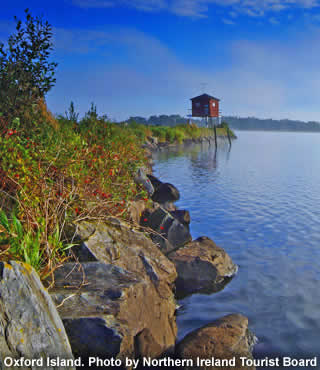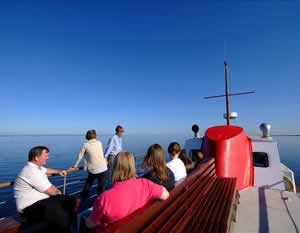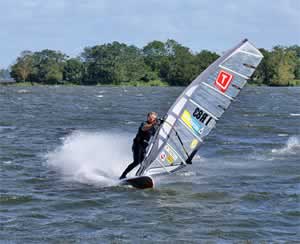Lough Neagh |
|
 |
|||
The largest lake in Britain, and Northern Ireland's centrepiece |
||||||||
Listen to this article |
||||||||
|
||||||||
Look at any map of Northern Ireland and you'll notice Lough Neagh, right in the middle. At 150 square miles, it's the UK's largest lake, even bigger than Windermere, or Loch Ness. Nearly half of the rain that falls on Northern Ireland ends up in Lough Neagh, which in turn supplies drinking water to the Belfast area. The lake's shoreline is shared by 5 of the country's 6 counties! |
||||||||
With such a key geographical location, it's no surprise that this is a popular destination for day-tripping locals. The lengthy shoreline is filled with interesting sights, from pretty towns to dense forests. |
||||||||
 A Boat Trip on Lough Neagh. Photo NITB |
||||||||
A good way to see the lake's varied features is to bike along the Lough Neagh Cycling Trail, which mostly follows the water's edge in a complete circle. It passes through all sorts of villages, parks and nature reserves. Keep an eye on the sky as you ride, because you might spot one of the 100,000 birds that travel here from such far-flung places as Canada, Iceland and the Arctic Circle. |
||||||||
You can find out more about the area's abundant wildlife at the Lough Neagh Discovery Centre, a beautiful building surrounded by water. As well as the various exhibits, there's also a craft centre and restaurant. Just to the west of here is Peatlands Park, where visitors can fully explore the sights - and smells - of natural marshland. |
||||||||
|
||||||||
Despite containing enough liquid to fill 7 million swimming pools, Lough Neagh is relatively shallow, with an average depth of just 9 metres. Nevertheless, you can still take boats on to the water. Over the last few centuries, large transport vessels used to carry products like coal and timber across the lake to the various connecting canals. There were also plenty of eel fishers, who still exist today. Their catches are served in restaurants across the globe. Nowadays, there are all sorts of craft on the Lough, from huge pleasure cruisers to a novelty pirate ship! You can hop on board at one of the four marinas, spread out along the shore. Adrenaline fans will find plenty of distractions at the various watersports centres, which offer such speedy activities as water-skiing and banana boating. |
||||||||
 Windsurfing on Lough Neagh. Photo 88rabbit |
||||||||
As the lake is a sizeable 20 miles long, it's not surprising to find several islands scattered along its length. The only one with permanent inhabitants, Coney Island, offers some spectacular views from its circular footpath. The largest is Ram's Island, a mile or so from the lake's eastern shore. Its most eye-catching feature is the round tower, a remnant of the area's rich Christian history. |
||||||||
 Rams Island in Lough Neagh. Photo L_J |
||||||||
|
||||||||
According to science, Lough Neagh was created when an earthquake created a hole for water to flow into. The locals, however, have a much more interesting story. In the distant past, a giant called Finn McCool scooped the land up himself, to throw at his Scottish rival. The makeshift projectile landed in the Irish Sea, creating the Isle of Man. |
||||||||
Strangely, neither of these stories explains the lake's name. "Neagh" is actually an ancient horse god, who's said to lurk beneath the waves. To this day, some fishermen can still hear his hooves, galloping through the water to the underworld. |
||||||||
|
||||||||
|
||||||||
|
||||||||
Maid of Antrim departs from Antrim Marina on the North East shore line every Sunday on the hour from 12 noon to 5pm and from Ballyronan Marina on the North West coast shore line on Thursday evenings at 7:30pm from Easter to Halloween. Booking. Cruises are subject to weather and demand, so please phone to confirm availability to avoid disappointment. Tel: 028 2582 2159 |
||||||||
Maghery Country Park is open daily 9am-5pm. Admission is free. It's 8 miles east of Dungannon, signposted from exit 12 of the M1. Lough Neagh Discovery Centre: 028 3832 2205 |
||||||||
|
Pocket Britain is optimised for use on a smartphone or tablet with internet access. All content is subject to copyright. All reasonable methods have been used to ensure information supplied is accurate at the time of publication. However, it is advisable to check information before relying on it. Privacy Policy |